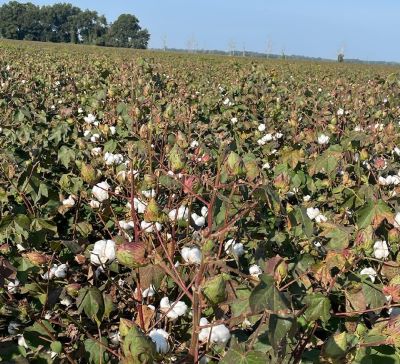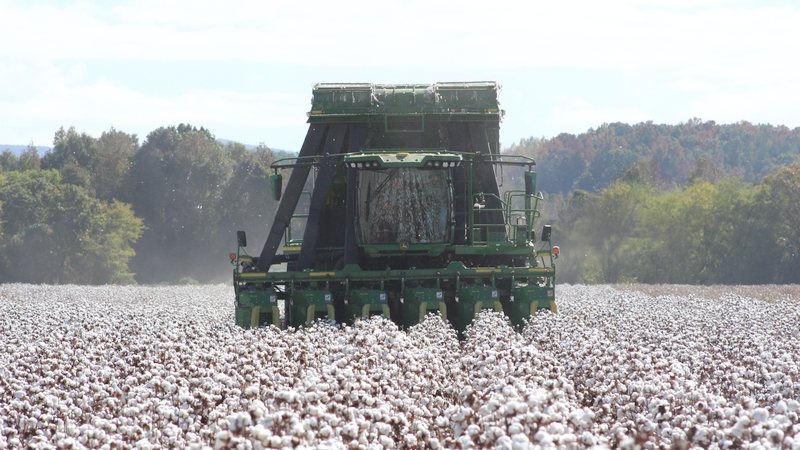Crop Scan Ag Report: Cotton Racing Toward Harvest
Overall, this year’s cotton crop seems to be racing to the finish line, as final management steps are being taken to preserve the top crop before defoliation begins on a broad scale.
Here’s what our contributing consultants are saying:
Chad Harrell owns and operates Harrell Agronomic Services in Northeastern North Carolina.
Considering the late start and cool weather we had in May, most of our cotton has done a lot of catching up this year. We are now only about a week behind normal in terms of maturity. All of the cotton has now cutout and is safe from insects.
The earliest cotton is opening up and will be ready to defoliate in about a week. We won’t have to wait for many top bolls to mature this year, as much of our top fruit shed during the hot dry weather in August. Many of our acres will be ready to defoliate in the next two weeks and all should be ready this month. Growers should be mindful of regrowth this year when defoliating if we continue to get rain.
I think our yields will be all over the board this year. We do have some strong 2-3 bale cotton in areas that received rain and below average cotton in others. So far, there is no hard lock. We just need to continue to miss these storms.
Wes Briggs consults on cotton, corn, peanuts, soybeans, and small grains for growers in Georgia, Alabama, and Florida.
Cotton is opening up, but we’re still pretty dry in a lot of places. We’ve defoliated a little bit of dryland cotton, but nothing has been picked yet. Our dryland cotton has pretty much done what it’s going to do. We’re talking about maybe a bale on some acres, less than a bale on others.
Overall, cotton is opening up good. We’re still probably two weeks from defoliating our first irrigated cotton. The good thing is we’re able to manage our water to help set this top third of the crop. Anytime we can do that, it’s always a positive for us.
 Top crop in Georgia (Wes Briggs)
Top crop in Georgia (Wes Briggs)
We’re still spraying for stink bugs in some of the later planted cotton and treating for whiteflies in spots where we needed to.
We have seen a lot of fruit shed this year due to the heat. And the late season problems we usually face like nematodes and fertility are showing up in spots in some fields.
We are still applying PGRs and foliar fertilizer as needed. We still have about a full month of management to go to finish setting this cotton crop and getting it open.
I’d say we have an average crop. We don’t have the crop we had last year, but we do have some good cotton in places. Some varieties have taken the heat better than others. Seed counts and pollination issues in some varieties are more evident this year, and that could play into next year’s variety selections depending on how it gins, turns out, and grades.
Tucker Miller is a Mississippi-based independent private consultant for cotton, soybeans, corn, peanuts, rice, and vegetables.
We started defoliation on a limited amount of acres this past week. We will start this Monday with a good bit of acreage to defoliate. This cotton was planted May 7 and 8. About a third of our acres were planted in this time frame. Our mid- to-late May planted cotton will need another week to 10 days before we can defoliate.
 First shot of defoliant (Tucker Miller)
First shot of defoliant (Tucker Miller)
We received a two-inch rain on the north end of our territory last week which will keep our late cotton going. We are expecting cooler temps next week and will alter defoliant recommendations if needed. We normally start with Dropp and Prep, then finish up with Prep and ET.
We have finished corn harvest and are currently cutting soybeans.
Our cotton crop still appears to be good, and we hope to get it out with no adverse weather. We do not need any more rain until November.
Hope everyone has a great harvest season.
Mark Nemec is an independent agricultural consultant for cotton, wheat, grain sorghum and corn in the Blacklands and Brazos River Bottom area of Central Texas.
The crop year is coming to an end in a hurry, but not the heat. Record high temps in the 100’s haven’t let up yet.
Dryland cotton is being harvested as I’m writing this (Sept. 7), and yields are not what we wanted or needed. They’re ranging from 100 lbs/A to about a bale, if lucky.
Defoliation attempts on irrigated cotton are starting now. I said attempts, because the dry and hot weather has made the cotton plants dry and hard to take in any product. There have been several different concoctions and ratios of products tried this year to get the leaves to come off. We are hoping it will get easier as we get to the fields that received better moisture.
Kerry Siders is Texas A&M AgriLife Extension Agent-IPM for Hockley, Cochran, and Lamb Counties.
Cotton here on the Southern High Plains of Texas has continued to be driven hard by high temperatures through the first week of September. We are hard pressed now to find cotton which would be considered late or behind at this point.
As I write this article today (Sept. 8), we are anticipating a considerable weather change at the end of this second weekend of September with potential for rain and cooler temperatures. The rain may be too late for some but will make shutting off irrigation on both pivots and drip systems an easier decision.
Insect pests are mostly in our rear-view mirror at this point. Stinkbugs and cotton aphids can hang on until the bitter end but have not been a serious threat here of late. Late season weed management efforts have mostly been to make harvest more efficient and to reduce seed numbers for next year.
We are starting to see more cracked and open bolls and would anticipate seeing some harvest aid applications going out the last week of September. Stay tuned.















